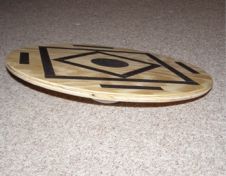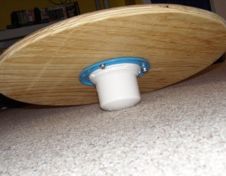|
Why use a wobble board?
The body has sensors all around it which
sense where parts of the body are even without looking. These sensors
are called proprioceptors. If the ankle or lower leg is damaged then the
proprioceptors can be damaged also.
If you have ever started to turn your
ankle over and it has automatically righted itself then this is the
proprioceptors working automatically to prevent further injury.
In the injured athlete these sensors will
not work so well, increasing the chance of re-injuring the leg or ankle.
This is why some people once they sprain their ankle, continue to sprain
it repeatedly.
Using a wobble board on a regular basis
can help retrain the proprioceptors and improve coordination, hence
preventing further injury. All the athlete has to do is stand on the
board and try to keep it horizontal - without the edges touching the
floor.
How to make your own wobble board
This
"how-to" requires a little bit more knowledge of shop class... but it's
still not too bad. First, get yourself a nice sturdy piece of
plywood. You're going to need about a 2 foot by 2 foot square.
Find the center, tap a nail in, and run a 12 inch piece of string from
the nail to a pencil. Rotate around the board, drawing a circle on
the plywood. Next, using a standard jigsaw, cut out the circle you
have drawn on the plywood. You will want to sand the edges to
prevent splinters. On the wobble board below, I used a 4 inch pipe
flange and cap and screwed it to the bottom side of the circle in the
center. Grip tape can be applied to provide more traction.
Considering that these simple balance tools can run you upwards of $50
and $60 online... this alternative is quite a bit more cost effective as
well as fully functional.


Wobble Board Exercises
(starting easy and getting harder)
1. Whilst sitting down place the wobble
board under the feet and slowly rotate it a number of times in each
direction.
2. Stand on the wobble board, feet
shoulder width apart. Hold on to a chair for support if needed and rock
the board forwards and backwards, then side to side. Do this for 2 to 3
minutes.
3. Stand on the wobble board, feet
shoulder width apart. Rotate the wobble board round so that the edge of
the board is in contact with the floor at all times. Again try this for
2 to 3 minutes.
4. Stand on the wobble balance board,
again feet shoulder width apart - no chair allowed! Rock the board front
to back for 1 minute then side to side for one minute.
5. Balance on the wobble board for as
long as you can without the edges touching the floor. Aim for over 2
minutes without touching the floor.
6. Rotate the wobble board in a circle
but do not allow the edge of the board to touch the floor. Aim for 2
minutes.
7. Stand on the wobble board with one
leg. Rock the board from front to back for 1 minute and then side to
side for 1 minute.
8. Again stand on the wobble board with
one leg only. Rotate the board in a circular motion in one direction for
1 minute then repeat in the other direction.
9. Try to balance on the wobble board
with one leg only! How long can you go for?
10. When you have mastered all of the
above you should have strong stable ankles and be an expert. Now try it
all with your eyes closed!!
Core and stability training
are becoming a very popular and effective means of exercise.
|
![]()